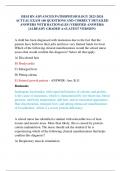Exam (elaborations)
HESI RN ADVANCED PATHOPHYSIOLOGY ACTUAL EXAM 160 QUESTIONS AND CORRECT DETAILED ANSWERS WITH RATIONALES (VERIFIED ANSWERS) |ALREADY GRADED A+(LATEST VERSION)
- Course
- Institution
HESI RN ADVANCED PATHOPHYSIOLOGY ACTUAL EXAM 160 QUESTIONS AND CORRECT DETAILED ANSWERS WITH RATIONALES (VERIFIED ANSWERS) |ALREADY GRADED A+(LATEST VERSION)
[Show more]



